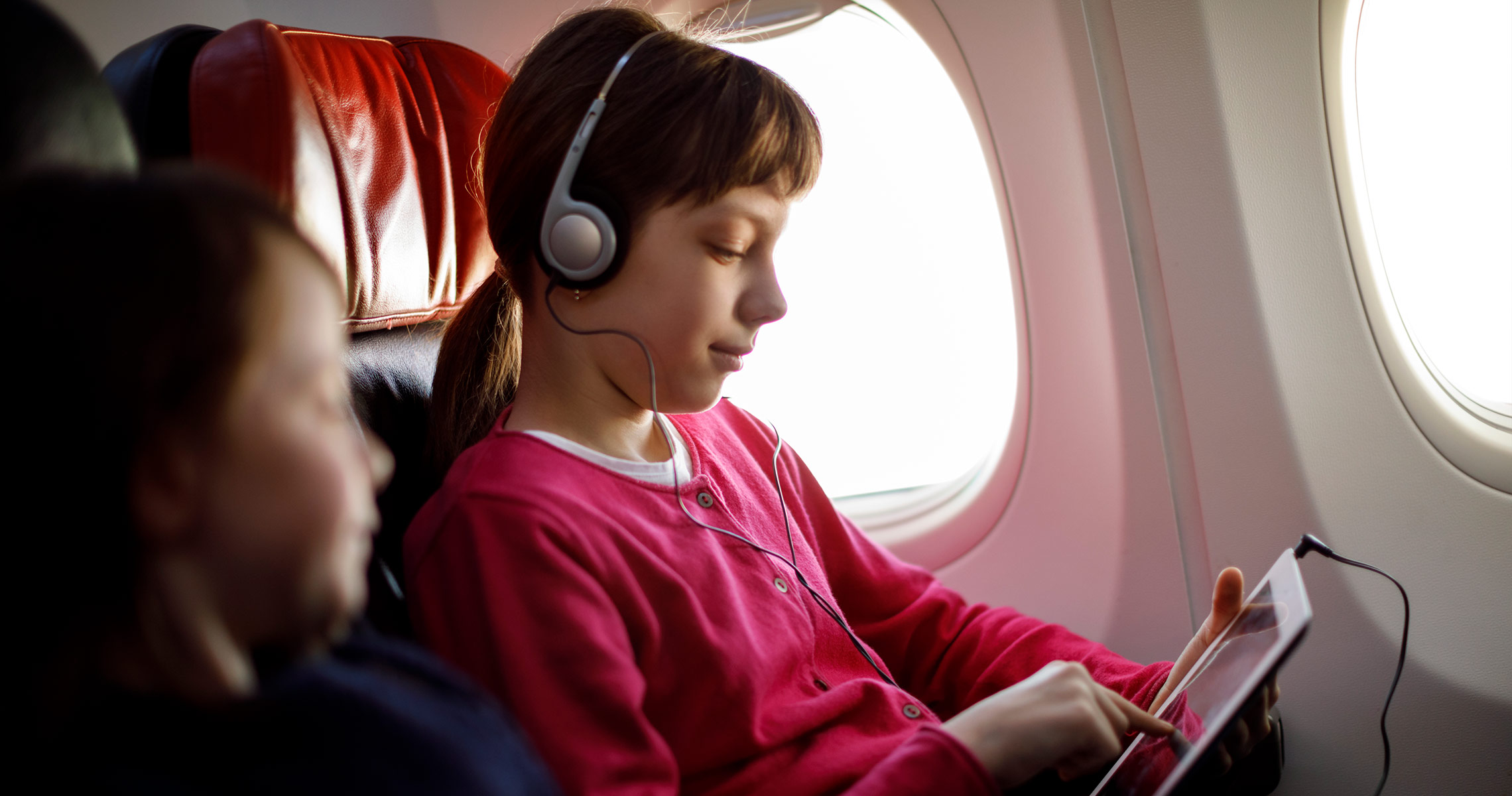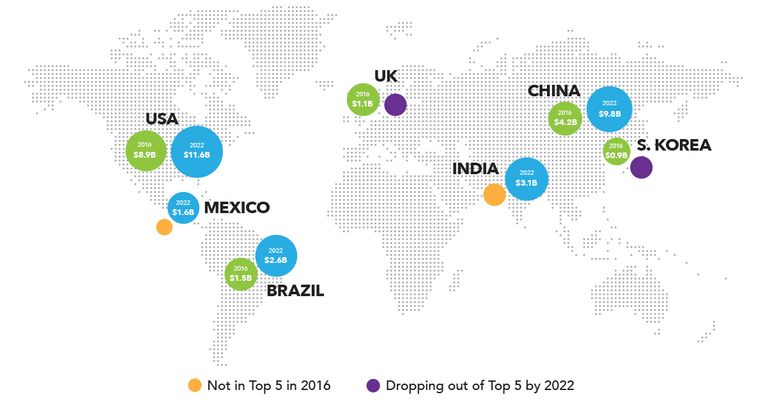Upside prospects drive new spending priorities
With travel regaining strength after the worst ravages of the coronavirus pandemic, there’s never been a better time for transport providers (“common carriers”) to pull out all the stops in the pursuit of financial recovery. Multiple research studies attest to the growing impact that passenger entertainment and other onboard services are having on common carriers’ fortunes.
One indicator is the pace of spending on in-flight entertainment options and connectivity (IFEC) solutions as ever more carriers take action to remain competitive. Such actions entail retrofitting existing fleets with new equipment and ensuring new planes, buses, and train cars meet the new in-flight entertainment requirements. According to MarketsandMarkets, the global market for IFEC solutions, which totaled $4.7 billion in 2021, is on a 5.2% CAGR trajectory to hit $6.1 billion by 2026. Similar studies by Mordor Intelligence and Orion Market Reports put the growth rate over the same span, respectively, at 6% and 7%.
The importance of IFEC to bottom lines was reflected in a recent survey of airlines, service providers, and original equipment manufacturers (OEMs) conducted by Intelsat, which found that airlines everywhere are focused on aligning IFEC services with their business objectives. With consumer demand for IFEC services expected to grow by 10% annually over the next decade, Intelsat said airlines are looking at how to leverage that demand. In some cases, the focus is on maximizing direct revenue from onboard entertainment services and, in others, by indirectly improving their balance sheets with superior user experiences that serve to draw more passengers.
As described in the research conducted by Mordor Intelligence, airlines’ efforts to recover from Covid-driven losses have led them to take action to ensure their IFEC services are in line with consumer expectations. Mordor notes carriers must now be responsive to the fact that, with the shift to streaming for traditional TV media and entertainment, people expect video to be delivered at full 1080p HD quality. And, like service providers everywhere, passenger entertainment providers understand the benefits to be gained in customer satisfaction if they’re able to deliver at least some content formatted for 4K UHD, possibly with HDR enhancements.

Even more crucial to customer satisfaction is the fact that, rather than being confined to viewing content on seatback screens, travelers want to access the content on whatever type of device they choose to use, such as tablet, laptop, or other mobile devices. In a passenger survey conducted in 2017, global airline industry supplier SITA found that 65% of airline passengers prefer streaming content on their own devices compared to 44% who like to use seat-back LCD screens. Inmarsat reported that 67% of passengers responding to a 2018 survey said they would be more likely to rebook with an airline that offers high-quality inflight Wi-Fi-based entertainment and connectivity.
With traffic coming back to pre-Covid levels, airlines that want to generate higher revenues and greater customer loyalty by meeting these expectations are equipping new aircraft and retrofitting in-service planes with Wi-Fi access points, routers, video servers and other elements of new passenger entertainment systems suited to their needs, according to SITA’s latest Airline IT Insights survey. “With the goals of boosting the agility and efficiency of operations for the [pandemic] recovery period, airlines are making aircraft connectivity a key investment priority,” the SITA survey said.
SITA reported 90% of respondents to the survey plan investments in wireless in-flight services, compared to 79% a year earlier, and ongoing commitments to investments in full satellite broadband connectivity were voiced by 74% of the respondents. These investments are a “key driver for ancillary revenue opportunities,” SITA noted.
The new in-transit entertainment infrastructure
Indeed, ancillary revenue opportunities abound, whether through charges for the connectivity or through partnerships that net carriers a share of advertising, e-commerce, or service usage revenues. Capturing such revenue streams is part of a larger industry-wide agenda that is driving ancillary revenue in multiple categories beyond entertainment, including charges for baggage, extra leg room, and commissions charged to hotels and car rental agencies promoted by the carriers.
According to a report from travel technology supplier CarTrawler, ancillary airline revenue totaled $65.8 billion worldwide in 2021, marking a 13% increase over 2020, and will go higher in 2022. A big part of the ancillary revenue agenda involves satisfying consumers’ demand for personalized services, said CarTrawler chief commercial officer Aileen McCormack. “Consumers are seeking more flexible, personalized services and offerings from airlines, opening up huge opportunities for the market,” McCormack noted.
Like their land-based counterparts, airlines have access to tools that make it possible to curate personal experiences and inflight entertainment with content selection, enhanced features, and targeted advertising. “As we look to 2022, the airlines that come out on top will be the ones that find creative ways to use ancillary services to meet the evolving demands of travelers,” McCormack said.
In all cases where video services are involved, the ability to derive ancillary service revenues begins with an on-board end-to-end closed distribution system that keeps travelers engaged with premium content offered over a secure entertainment portal. In cases where live content is offered, the feed or feeds from outside services are ingested for distribution over the closed on-board system.
Fortunately, installing a Wi-Fi system that supports the bring-your-own-device (BYOD) access option is far cheaper than installing a dedicated in-flight entertainment system with seat-back LCD screens, remote controls, headsets and wiring. The latter can cost as much as $6 million per plane, according to commerce data compiler Zauba, and can become a nightmare for onboard staff if a major malfunction occurs.

As noted earlier, common carriers’ ability to draw viewers by offering the most compelling content possible, whether live or on-demand, is fundamental to executing successful monetization strategies. This means the content protection platform used in the onboard entertainment system must be able to meet stringent studio licensing requirements for premium content, applying digital rights management (DRM) technology essential to serving every type of consumer device. In part 2 of this two-part blog series we will review the requirements for onboard content security and a solution that fulfills them all.






